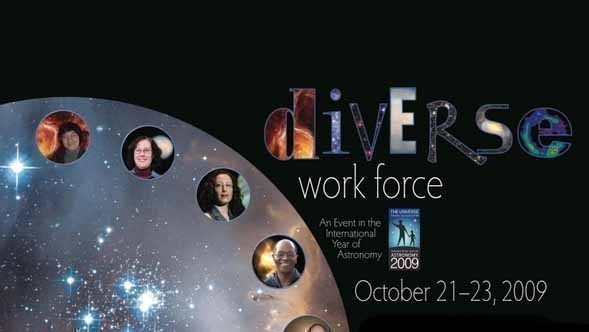
By Luisa Rebull | November 6th, 2009
I've just come back from a slew of travel, including the 3rd ever Women in Astronomy conference, which was at the end of October. I'd been to both of the previous conferences like this -- the first was in 1992, in Baltimore, and I was just between college and graduate school when I went. The second one was in 2003, and that one was at Caltech (and I was a new staff member here when I went to that one too). This one was back in the DC area, and so I went back to the East Coast to attend.
One of the neatest things about these conferences is the sheer numbers of women. As a woman in astronomy, I am used to being a minority at any given conference or committee meeting. Women make up about 25% of the astronomical community, and so it's relatively rare that I sit in a meeting, I look around, and see only few other women. Usually, any given group of astronomers is at least 25-30% women. But at this meeting, there were 280 registrants, and something like 250 of them were women. This is highly unusual for an astronomy meeting, and it's surprisingly energizing. And it's very unusual to have to wait in a line at the restroom! Here we all are.
This meeting deliberately scheduled a lot of networking time, and I used it to good advantage -- I made a lot of connections and I think that several of them will bear fruit.
The meeting also presented a lot of interesting statistics and fostered a lot of discussion about issues that we still face as well as coping mechanisms, and ways to help support women and minorities in the space sciences. The conference organizers will be posting presentations and proceedings on the website above, but here are some semi-random points that stuck in my head.
There are about 8000 members of the American Astronomical Society (AAS), the astronomer's professional society. Overall, the fraction of women goes up dramatically as you look at younger and younger ages. In the lowest age bin (college age), it is half women. At older bins (new PhD ages), it's about 30%. This is up from about 20% which is where it was about 10 years ago. The fraction of minorities is downright pathetic. This is clearly where our efforts have to go in the upcoming years. The fraction of women astronomers in other countries is hard to track, and fluctuates a lot, but there are some surprising trends -- there are a stunning fraction of women astronomers, apparently, in places like Argentina, but those numbers can't be separated from the salaries and status levels of those jobs; if there's little pay and no status, then it might not be all that surprising that there are a high fraction of women in those jobs, since the men take other jobs.
I knew the following from the 1992 and 2003 conferences: data were presented again from the social sciences that the same paper written by Jane, James, and J. Smith got different ranks -- James was ranked highest, Jane was ranked lowest. So I publish as L. M. Rebull -- have done so my entire career (when I'm first author).
Again, looking at data from the social sciences, they now have evidence of the old adage that a woman needs to do twice as well to be considered half as good. Women had to publish 2.5 times as much as men to be ranked comparably in a recent sociology study. Argh.
It's also now been documented that women who let it be known that they are mothers (as I am) were ranked more harshly than women who were not mothers, and men who were fathers were ranked more highly than men who were not fathers (Corell, Benard, and Paik 2007). Argh, again.
As we discussed in 2009 (and in 2003), these effects come from the fact that we all have internal biases. It is part of what makes us human, and having the biases is unavoidable. Realizing this and dealing with them is important. There is a website at Harvard that enables you to investigate your own hidden biases. The sociologists have a name for these biases : "schemas." These assumptions, profiling, snap judgments, stereotypes, whatever you want to call them, enable us to function quickly in new situations. If we can assume that a new stoplight of a sort we've never seen before will operate in the same way as other stoplights we've seen, it enables us to assess the situation quickly, and avoid car accidents. We do the same thing with people. But people are more diverse, and often our internal stereotypes do not reflect reality in the case of the group or the individual. Often these assumptions allow us to quickly assess the situation and move forward. But often they do not work. I can think of two pop culture examples. In the movie Legally Blonde, schemas are explicitly crucial to the movie's plot -- everyone (including the audience) assumes that since the main character, Elle, is a petite, attractive blonde (who majored in fashion and was active in her sorority) that there is no way she could be a good lawyer. In this case, Elle is continually battling schemas. In the TV show The Closer, the importance of schemas is more subtle -- people assume that Brenda, a petite blonde with a southern accent, must be dumb. That assumption often traps the criminals into confessing, which is critical to Brenda's success. In this case, she is explicitly making the schemas work for her. We are not often (ever?) shown the situations in which the schemas hurt her, and as a high-ranking woman in a (mostly male) big city police force, it must hurt her from time to time; I wonder what her real-life counterparts would have to say about their lives as portrayed in this show.
Schemas affect all of us, whether we are the members of a minority group or not. Sometimes this is to our benefit, sometimes it is not. Can you think of an instance in your life where others' schemas helped you? Or hurt you? The best we all can hope for is to be aware of these schemas, sensitive to when we might be applying them (especially in the case of evaluating job applications or considering talk invitations, etc), and take steps to avoid applying them in cases where it would hurt ourselves or others. When possible, we need to point out these inequities and do something about them. For example, for years, there were very few female professional musicians in major symphonies. When they implemented blind auditions (where the musician applying for the job walks across a rug -- to avoid the betraying sound of a woman's shoes -- and auditions behind a screen for the judges), the fraction of women rose dramatically to 50%. This change to the process benefited the women, and it also benefited the orchestra as a whole, since now the jobs have gone to the best musicians and the overall quality must have gone up as a result. Try to be aware of all the (unconscious!) assumptions you make about other people on a daily basis, and the implications of those assumptions!
Watch the meeting website for proceedings in the near future, including statistics and summaries of discussions and working groups.
 December craziness
December craziness
 Universe Expanding
Universe Expanding



